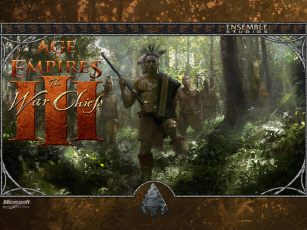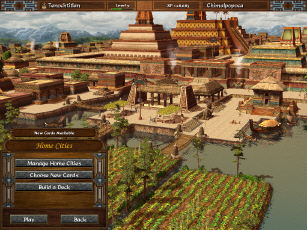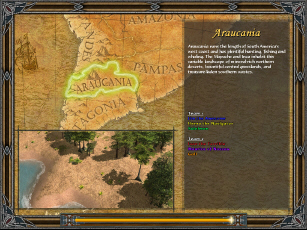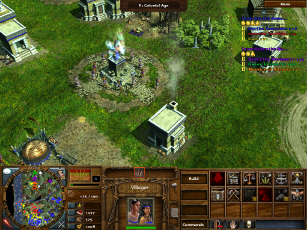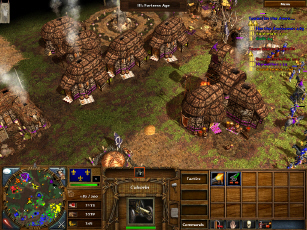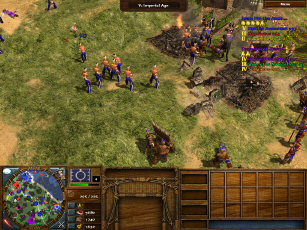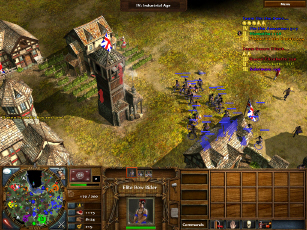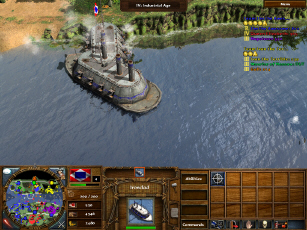|
|
||||||||
INDIGENOUS POWERS THE WARCHIEFS EXPANSION FOR MICROSOFT'S AGE OF EMPIRES III
There is an enduring pattern for real-time strategy [RTS] games, particularly those from Microsoft. First, the game is released, usually with substantial fanfare. Then a year later the company releases the rest of the game, in the form of an expansion. It happened with the first two Age of Empires games, finished with The Rise of Rome and The Conquerors respectively, and also with Rise of Nations, completed with Thrones and Patriots. Finally, the company sells the products combined into a "Gold Edition," in which the word "gold" could be replaced with the phrase "at last, complete." The expansions always come with new powers to play, new units for everyone, and fresh campaigns and scenarios. The first two are really the more important though, as additional sides and fleshed-out orders of battle are applicable in many other situations as well. For those of us who have an affinity for the games that verges on addiction, it is not necessarily an evil practice. We get the first half the game, play it to death for a year, then get the other half, and play it to death for a lot longer, seldom if ever returning to the original, unenhanced version. If the practice were all that bad, we would stop buying and playing, but we do neither. The latest example of this is The Warchiefs, the expansion to Age of Empires III. The latest installment of the Age of Empires franchise concentrates on the New World, with the theme of colonization. In the core game, the native peoples can be coopted as subsidiary allies, but are not actors themselves, not even on their own stage. The Warchiefs fixes that. In addition to the original European nations, players can also play the Iroquois, Sioux and Aztecs. Considering that the Iroquois Confederation conducted a sophisticated foreign policy balancing Britain and France, at least until the French and Indian War made them choose a British alliance, including them as an independent, active power is an inspired one. The Aztecs too are an excellent choice, as they were the most powerful nation in the Americas, with the possible exception of the Incas. The Sioux lacked the central cohesion and sophistication of the other natives introduced in The Warchiefs, but their horse culture adds a new element to the game. The new Native sides are not that alien to the Europeans, at least in game terms. The Iroquois and Sioux each has a Tribal Council instead of a Home City, but considering that that is solely to allow the player to manage his cards, that is more nominal than substantial. They can harvest resources, handle production, and even forge alliances with the other, non-player Indians in the same manner as the Europeans. As with the existing powers, each of the new nations represents a variant on the Age of Empires-family model, with some variations. The Sioux have their reliance on the horse, with foot units generated at war huts that function the same as barracks for most of the Europeans. Uniquely, Sioux do not have siege workshops, and so do not have access to the same heavy weapons as any of their competitors. Also, similar to the Huns in The Conquerors, they do not need houses to sustain their population. They do have tepees, but enhance the survivability of buildings located nearby. The Aztecs alone are carryovers from Age of Empires II, The Conquerors to be perfectly accurate, and reflect an entirely different way of life and war to that of the Sioux. They too lack siege workshops, and also have absolutely no cavalry, making up for both with one of the widest ranges of infantry in the combined game. The Iroquois are somewhere in the middle. Their game portrayal reflects their greater access to European technology, with the customary triad of infantry, cavalry, and siege units, though their artillery is distinctly limited. All independent Indian civilizations benefit from a different, non-European relationship with the natural world that borders on magic. All can build firepits from the beginning of the game, where civilians are sent, just the same as farms and plantations. Firepits can speed production, increase the capabilities of other units in combat, and produce medicine men (warrior priests for the Aztecs), healers who function the same as colonists' priests and imams. No civilization can have more than one firepit at a time. However, the player can have up to twenty-five civilians assigned to it, making it a powerful force multiplier. Instead of explorers, the new Indian powers have warchiefs, which give the expansion kit its name. Like their European counterparts they are named units, with one per side, that take on the same roles as explorers; reconnaissance, treasure acquisition, and ambassadors to non-player Indian tribes. They have different powers though, which those emanating from firepits, are quasi-supernatural. In the initial release of Age of Empires III, European explorers have special combat capabilities, which permit them to pick off one treasure guardian with impunity before combating the others. Later on, some pick up the ability to attack more than one enemy at once, one time in an engagement, with less immediately lethal results. Indians go about matters differently. Instead of killing an enemy at the outset, a warchief can, with a wave of his hand, bring him over to his own side. This works out better than the European sharpshooter capability, as in a fight it does more than kill the target, and the results last after the combat is over. In the short term warchiefs tend to be more effective against treasure guardians than their counterparts. In the long term, a warchief can amass a small army of outlaws, wolves, bears and alligators. The product gives the Europeans new units as well as new opponents. There is a new building, the saloon, where a player hires a variety of always expensive, usually sinister mercenary types. A player can also recruit spies, who can further double as assassins. Stealth is a new element to the game, and is shared with other units, including one Sioux "Tashunke Prowler," on horseback. Other additions are produced at the siege workshop. Horse artillery are unusually mobile cannon, and petards are suicide bombers, similar to those in Age of Empires II. The Warchiefs introduces the possibility of truly revolutionary change in the nature of a European power. The player can declare a revolution, and have the appearance of his home city and his flag change to reflect that a new country has been founded. He also loses the economic production of all of his villagers, who become armed militiamen. Finally, his cards change to a special revolution deck. He gains access to more advanced technology too. There are gatling guns that can mow down enemy forces, and ironclads, the most durable naval units available. For the most part, the expansion kits to RTS games present incremental though certainly welcome improvements. One can expect some new countries, maybe with a slightly different take on the basic model, and a few new units. There will be new scenarios and campaigns too, and maybe some maps for randomly-generated games. In this case, The Warchiefs goes a little further than usual. The three new civilizations are fewer than most products; The Conquerors, for example, introduces five. Yet they are substantially different in practice than any of the Europeans, even the Ottomans, despite having similar core characteristics. They reflect dramatically different relationships with nature, in which individual, non-player foes can be coopted, the same as Indian tribes, instead of killed as an act of diplomacy. In addition, the concept of the firepit is basically non-European, except maybe as a means of quantifying the power of prayer, but translates into a steady economic and military boost. It is not to be ignored, and an Indian player seldom does wrong by diverting villagers to the firepit. Gamers should be aware too that in my case at least, there are some troubling aspects to the software's technical performance. The minimum requirements for the game are on far from out of reach by most machines today; 256 MB of RAM, a 1.8 GB processor, and a video card with 64 MB of dedicated memory. My desktop computer exceeds all by a wide a wide margin. It might be a Pentium 4 in a world increasingly inhabited by multi-core processors, but by the standards listed on the box, it should be quite serviceable for The Warchiefs. Yet the software continues Age of Empires III's behavior in seeming to want more and more. The video clips, and that is all of the clips, run in jerky manner, ending up a lot more irritating than impressive. Much of the animation in the game itself is no better. From a game perspective, the worst comes when trying to select units on the map. Drawing a box to select multiple units is almost always a problem. Frequently, the box does not appear in the same place as the cursor, some place to the right, and grows slower than the mouse moves. Even if the gamer gets the selection in the right place, it almost never includes all of the friendly forces in its range, if the player wants to get a big army on the move. Finally, and this is probably the most maddening of all, it has a bad habit of immediately unselecting most if not all of the units the player wants. The results can have a major effect on game play. For example, one can try to amass a balanced military force of infantry, cavalry, and artillery, with a few healers in support, and then end up with only one unit, too often the weakest one, such as a settler or priest. Alternatively, The Warchiefs will disregard the selection altogether, and select a tree or building. The effects of the latter can be persistent, as it is quite easy to miss the software's mistake and instead of setting an army's destination in enemy territory, will put the building's rally and production point there, sending new units far away where they will be at least unproductive and at most destined for immediate slaughter. As stated, none of this is new, and has been with Age of Empires III since its introduction in late 2005. Nonetheless, Age of Empires III enthusiasts will want The Warchiefs for their hard drives. A few, lacking either an addictive compulsion to play the game or perhaps the readily disposable income, might be willing to wait for the Age of Empires III Gold Edition, whenever that might come out. No matter what though, this should be seen as something other than an optional expansion to an otherwise complete software package. Instead, it is the rest of the game.
|

